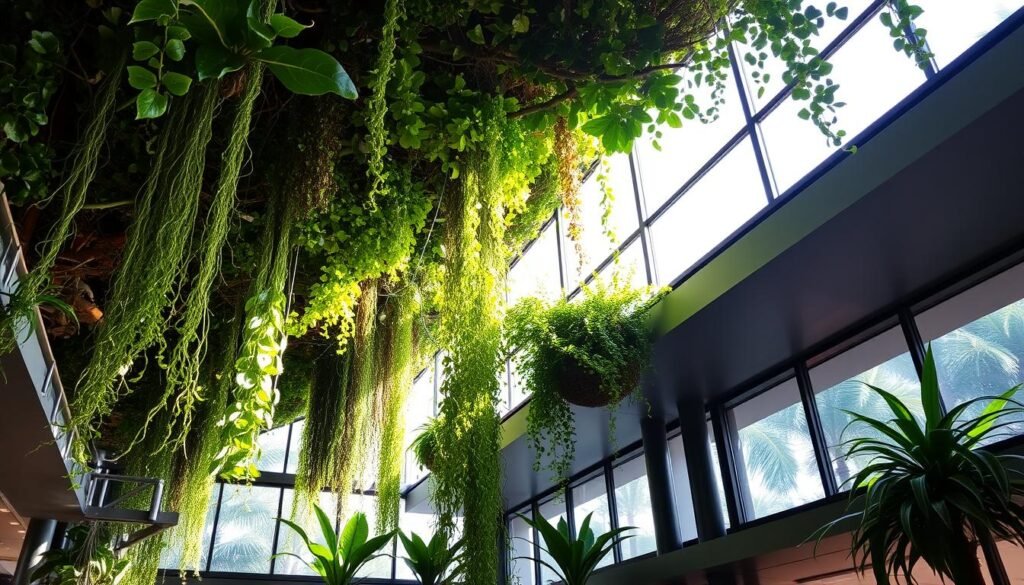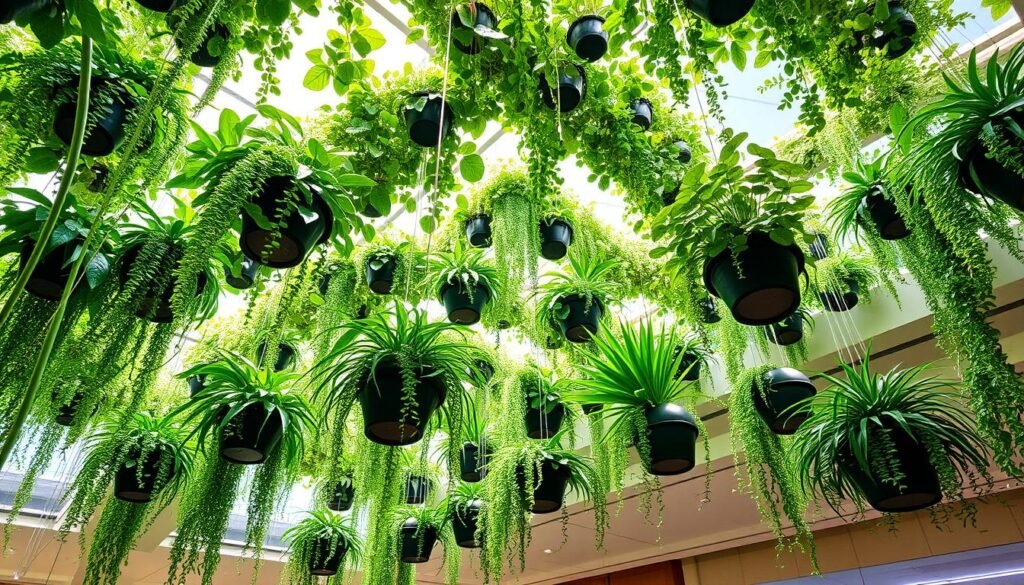Imagine a world where nature blooms above, creating a peaceful and captivating atmosphere. This is what living ceiling design offers – a new way to bring greenery into our buildings. It changes how we see and feel our surroundings.
As a designer and lover of nature, I find living ceilings amazing. They bring the outdoors inside, making us feel calm and connected. It’s more than just pretty – it’s good for our health and happiness.
In this article, we’ll explore living ceiling design. We’ll look at how it has evolved and its impact on our spaces. Whether you design buildings or just want to bring nature inside, this will show you the endless possibilities.
Key Takeaways
- Living ceiling design seamlessly integrates suspended greenery into architectural elements, creating a captivating and serene indoor environment.
- This design approach offers a multitude of benefits, including enhanced well-being, productivity, and a deeper connection with nature.
- The article explores the evolution of green architecture and the growing trend of incorporating biophilic elements into ceiling installations.
- Readers will learn about the essential elements for successful living ceiling design, including plant selection, structural considerations, and maintenance requirements.
- The article also covers sustainable features, environmental impact, and the installation process, providing a comprehensive understanding of this innovative design solution.

Understanding Living Ceiling Design: Nature Above Your Head
Living ceiling design takes green walls and vertical gardens to new heights. It brings nature into your home in a unique way. These systems not only look great but also offer real benefits to those who live there.
Benefits of Overhead Biophilic Elements
Green walls, vertical gardens, and living walls in ceiling design help us feel better. They make us relax and feel more connected to nature. Research shows they can lower stress, improve thinking, and make us more productive.
Key Components of Living Ceilings
- Specialized planting systems designed for overhead installation
- Lightweight, modular frameworks to support the growth of greenery
- Integrated irrigation and nutrient delivery mechanisms
- Lighting solutions to ensure optimal plant growth
Types of Living Ceiling Systems
| System Type | Description | Key Features |
|---|---|---|
| Suspended Planters | Hanging planters suspended from the ceiling | Versatile, easy installation, suitable for a variety of plant species |
| Integrated Panels | Modular panels with built-in planting cavities | Seamless integration, optimized for plant growth, customizable designs |
| Hydroponic Trays | Soil-less, water-based planting systems | Efficient nutrient delivery, reduced maintenance, clean aesthetic |
Architects and interior designers can make amazing spaces with living ceiling designs. These designs are not only beautiful but also good for the environment. They help people feel connected to nature.
The Evolution of Green Architecture and Suspended Gardens
Green architecture has changed a lot over time. It now focuses more on being sustainable and using nature in design. Suspended gardens and living ceilings have become key parts of this change. They change how we see and feel about buildings.
The idea of suspended gardens started with the Hanging Gardens of Babylon. This ancient wonder, built around 600 BC, showed how plants could be part of buildings. It inspired new ideas in green architecture and sustainable interiors.
In the 20th century, architects started to bring nature into buildings. Places like the Fuji Kindergarten in Japan and the Bosco Verticale in Italy showed how green spaces can improve buildings.
“Integrating nature into the heart of our structures is not just aesthetically pleasing; it has far-reaching implications for human well-being and environmental sustainability.”
Now, living ceilings are becoming more popular. Architects and designers are making spaces that connect us with nature. These spaces, from green roofs to vertical gardens, are changing how we see buildings.
The need for green and healthy designs is growing. Green architecture and suspended gardens will be key in shaping the future of cities and buildings.
Essential Elements for Successful Living Ceiling Design
Creating a living ceiling with indoor gardening or eco-friendly ceiling needs careful planning. You must pick the right plants and set up strong support systems. Each step is crucial for a living ceiling that stays vibrant and healthy.
Plant Selection and Maintenance Requirements
The choice of plants is key to a living ceiling. You need to think about light, growth, and care needs. Choosing plants that are easy to care for and can handle shade makes for a beautiful and lasting ceiling.
Structural Considerations and Support Systems
The ceiling’s structure is very important. You must check how much it can hold and how to anchor it well. Using trellises or panels helps keep the plants stable and growing.
Lighting and Irrigation Solutions
Good lighting and watering are vital for the ceiling’s plants. LED lights or natural light can help. Automatic or manual watering keeps the plants moist. These systems make the ceiling healthy and long-lasting.
| Key Consideration | Importance | Best Practices |
|---|---|---|
| Plant Selection | Curates the living aesthetic and influences maintenance requirements | Choose low-maintenance, shade-tolerant species Ensure plant compatibility with lighting and environmental conditions Diversify plant types for visual interest and ecological balance |
| Structural Support | Provides a secure and stable foundation for the living elements | Assess load-bearing capacity and weight distribution Implement robust, customized support systems Ensure secure anchoring and integration with the existing structure |
| Lighting and Irrigation | Optimizes plant growth and longevity | Strategically position lighting sources for adequate illumination Integrate automated or manual watering systems Monitor and maintain optimal moisture levels |
By focusing on these key areas, you can make a beautiful and lasting indoor gardening or eco-friendly ceiling. It will be a stunning addition to your home for years.

Incorporating Biophilic Design Principles in Ceiling Installations
The trend of biophilic design is growing fast. It aims to connect us more with nature. Using this in ceiling designs can change how a room feels and how healthy it is.
Biophilic design often includes plants in buildings. This brings the outdoors inside. It adds beauty and health benefits to sustainable interiors.
Nurturing the Connection with Nature
Green ceilings and hanging gardens calm us down. They tap into our love for nature. These designs do many good things, like:
- Connecting us to the outdoors
- Making spaces more interesting
- Cleaning the air we breathe
- Helping us relax and feel better
Designing for Optimal Integration
Designing green ceilings needs thought. You must pick the right plants, lighting, and water system. This way, the ceiling looks good and works well with the room.
| Biophilic Design Principles | Application in Ceiling Installations |
|---|---|
| Connection with Nature | Overhead greenery and suspended gardens create a visual and physical connection to the natural world |
| Sensory Experience | Carefully curated plant selection can engage multiple senses, such as sight, smell, and touch |
| Natural Patterns and Forms | The organic shapes and textures of living ceiling systems can mimic natural elements |
| Spatial Complexity | Layered and dynamic ceiling installations can create a sense of visual interest and depth |
Using biophilic design in ceilings can make them amazing. They become places that feel like nature. This makes spaces better for our health and the planet.

“Biophilic design is a powerful tool for creating spaces that nourish the human spirit and foster a deeper connection with the natural world.”
Sustainable Features and Environmental Impact
Living ceiling design is becoming more popular as people want eco-friendly ceilings and green buildings. These overhead installations are not just pretty. They also have many benefits.
Energy Efficiency Benefits
Living ceilings can make buildings more energy efficient. The green plants help keep the temperature inside stable. This means you use less energy for heating and cooling.
This not only saves money in the long run. It also helps the environment by using less energy.
Air Quality Improvements
Living ceilings clean the air by removing pollutants and adding oxygen. This makes the air healthier to breathe. It’s good for people’s health and makes them more productive.
The plants in living ceilings also get rid of harmful chemicals. This makes them a key part of eco-friendly ceilings and green buildings.
Acoustic Enhancement Properties
The plants and soil in living ceilings are great at absorbing sound. This can make places quieter and improve how well you can hear. It’s good for offices, schools, hospitals, and homes.
Living ceiling design is a smart choice for those who care about the environment. It looks good and helps with energy, air, and sound. It’s a win-win for everyone.

Installation Process and Professional Requirements
Creating a living ceiling design is a detailed process. It needs specialized skills and careful planning. Working with experienced pros is key for a successful and lasting living ceiling system.
Design and Planning
Start by teaming up with a living ceiling design expert. They will look at your space, think about lighting, structure, and environment. Then, they’ll make a plan that makes your green walls look great and work well.
Installation Expertise
Getting your living ceiling installed right is crucial. Skilled installers will set up the support, add irrigation and drainage, and plant the greenery. They’ll make sure your overhead garden looks amazing and stays healthy.
Ongoing Maintenance
- Regular watering and nutrient replenishment
- Pruning and trimming to maintain shape and health
- Monitoring for pests or diseases and implementing appropriate solutions
Working with pros from start to finish ensures your living ceiling design is done right. Your green walls will keep thriving for many years.

| Design Considerations | Professional Requirements |
|---|---|
| Structural analysis Lighting and irrigation planning Plant selection and layout | Experienced living ceiling design specialists Skilled installers with specialized knowledge Ongoing maintenance and monitoring expertise |
“Investing in professional guidance ensures the long-term success and sustainability of your living ceiling design project.”
Maintenance Tips for Thriving Living Ceilings
Keeping your indoor garden or vertical garden on the ceiling healthy is a rewarding task. But it requires care. Here are some key tips to help your ceiling garden thrive.
Watering and Nutrition Schedules
It’s important to water your living ceiling plants regularly. The frequency depends on the plants, soil, and environment. Check the soil moisture and water when it’s dry a few inches down.
Also, give your plants a balanced fertilizer every few weeks. This helps them grow well.
Pruning and Plant Health Monitoring
Pruning keeps your living ceiling looking good. Trim any stray or damaged leaves. Remove dead or dying parts too.
Watch your plants for pests or diseases. Deal with problems quickly to keep your garden healthy.
Common Issues and Solutions
- Yellowing leaves: Caused by overwatering, nutrient deficiency, or insufficient light. Adjust your watering schedule and consider adding a supplemental grow light.
- Wilting or drooping leaves: Could be a sign of underwatering or root rot. Check the soil moisture and adjust your watering accordingly.
- Fungal growth: Address this by improving air circulation, reducing humidity, and treating with a fungicide if necessary.
Stay on top of maintenance and fix problems fast. This way, your indoor garden or vertical garden will keep thriving. It will also make your space more beautiful.

| Maintenance Task | Frequency |
|---|---|
| Watering | Check soil moisture regularly, water when top 2-3 inches are dry |
| Fertilizing | Apply a balanced liquid fertilizer every 2-3 weeks |
| Pruning | Trim back any overgrown or damaged foliage monthly |
| Pest/Disease Monitoring | Inspect plants weekly for any signs of issues |
“Maintaining a living ceiling takes dedication, but the rewards of having a lush, thriving overhead garden are well worth the effort.”
Cost Considerations and ROI Analysis
Investing in a living ceiling design can be a smart choice. It boosts the look of a space and offers long-term benefits. When looking at costs, consider the initial setup, ongoing care, and the return on investment (ROI).
The cost to set up a living ceiling varies. It depends on the project size, design complexity, and needed parts. Think about the plant costs, support systems, irrigation, and lighting. Although it might seem pricey at first, the long-term gains can be worth it.
Living ceilings can also save on energy and cut down on costs. Plants help with insulation, temperature control, and air quality. This can lower heating and cooling bills. Plus, they can make employees happier and more productive, which can help businesses save money.

Hello, I’m Jane, founder of Home Vibe Ideas. I’m here to inspire stylish Home Design, modern Smart Living, beautiful Outdoor Spaces, and creative DIY Projects to help you create a home that’s uniquely yours.
Disclosure: This post contains affiliate links. If you click on a link and make a purchase, we may earn a small commission at no additional cost to you. The content on this site was created with the help of AI technology.


